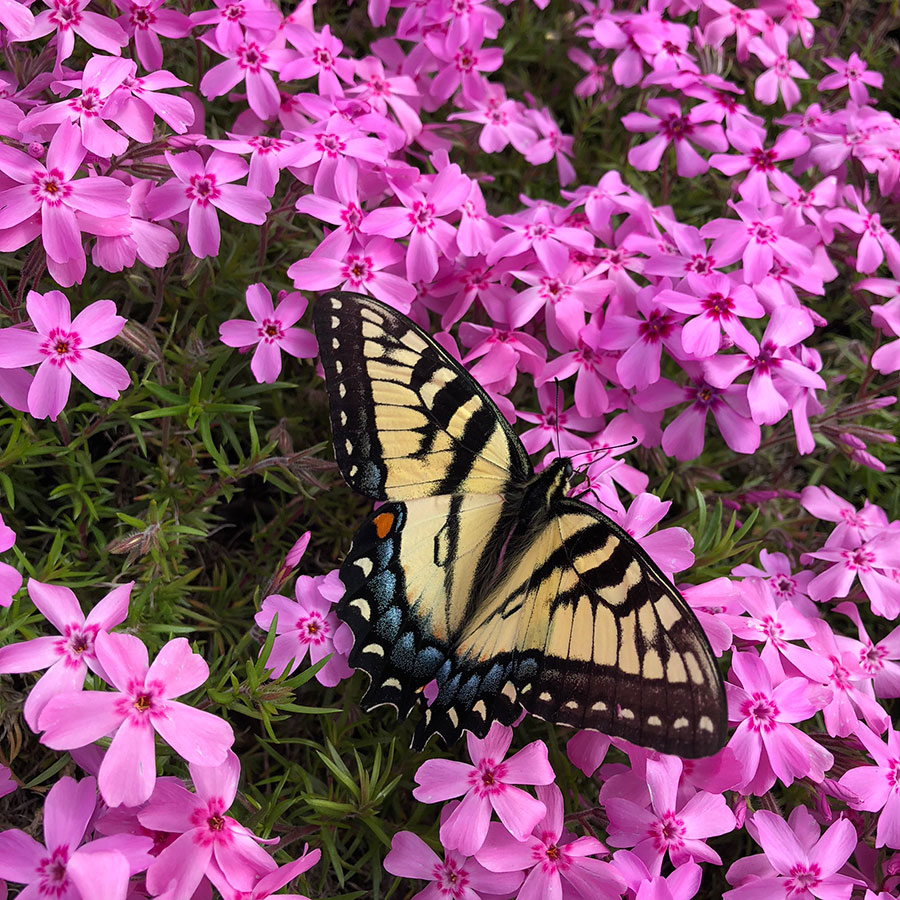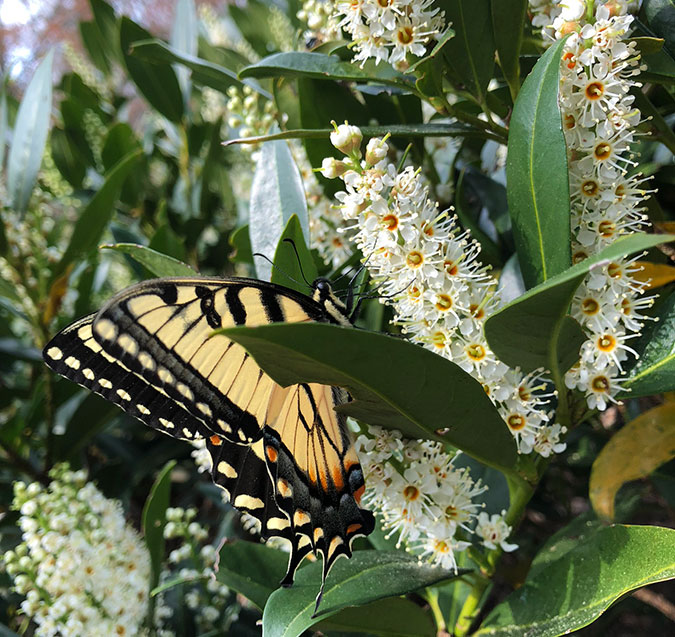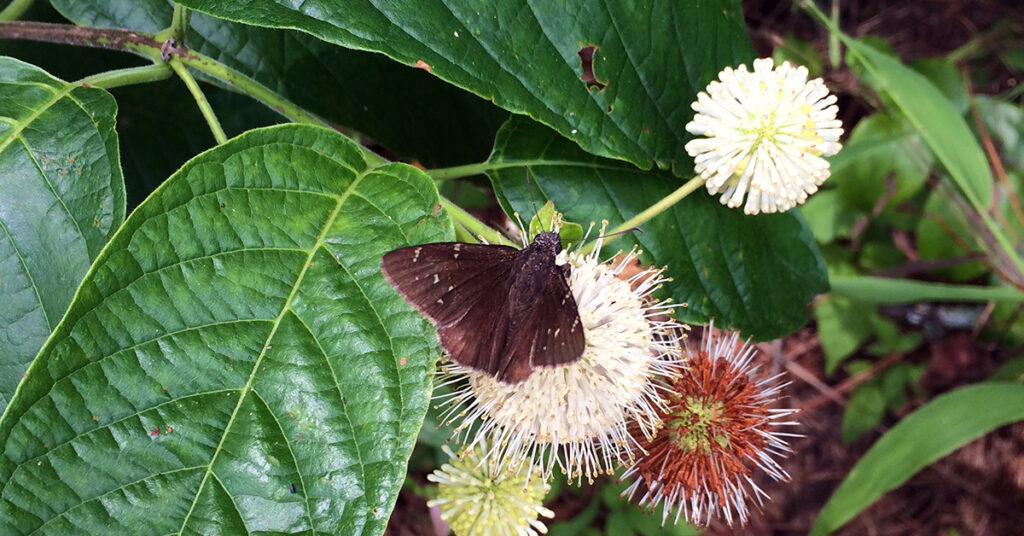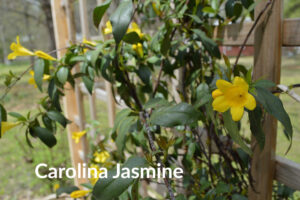This early spring sky is filled with butterflies! I am seeing so many eastern tiger swallowtail butterflies (Papilio glaucus) feeding on colorful spring flowers that it has really brightened my days.
Eastern tiger swallowtails are quite large – with a wingspan of 3 to 5.5 inches and with their bright yellow wings with blue spots, they put on quite a show. If you want to bring them to your garden, there are some early spring flowering plants that they can’t seem to resist.
Eastern tiger swallowtails are the state butterfly for Georgia, Alabama, Delaware, and South Carolina. Male eastern tiger swallowtails can be identified by darker black spots on their wings and they will be missing the blue and red colored scales seen on the hind wings of the females.
Plants that bloom in early spring
This season, I am seeing lots of these butterflies around these shrubs and perennials in particular. Try a few in your garden mixed in with other later blooming plants and summer/fall blooming plants to attract butterflies all season round.
Creeping phlox (Phlox stolonifera)
Ground cover, USDA zones 3 to 9
The bright pinks, purples, and whites of creeping phlox mixed with the blue of Lithodora really make for a pretty color combination. Some creeping phlox has a very sweet scent too.
Creeping phlox spreads easily and can be grown in a rock garden, in the ground in most soils (just be sure it doesn’t stay too wet), and even in containers. It’s a low maintenance plants and the flowers bloom in March and April for several weeks at a time. Different colors bloom at different times, allowing for a cascade of color in early spring. Plant in full sun.
The leaves are somewhat evergreen and will persist in warmer climates throughout the winter. The plants average a height of about 2 to 3 inches and can spread widely. Older parts of the plants will stop producing blooms and can be removed.
Dividing phlox is as simple as splitting the plant with a sharp shovel and being sure dig up as much of the roots to accompany the divided plants. The roots are pretty shallow, so it should be a pretty easy task.
Cherry laurel (Prunus laurocerasus)
Shrub, USDA zones 6-8
When late March arrives, this bush is in full bloom with showy, fragrant, cream-colored flowers clustered on a raceme. The blooms persist until May.
The three shrubs I saw just this week were hosting a dozen of the brightly colored eastern tiger swallowtail butterflies which were feeding and flying all around.
The leaves are waxy, dark green, and evergreen. In states with very hot summers, plant your cherry laurel in part-shade for best growth, and in states with milder summers, plant it in full sun. Cherry laurel prefers well-drained but moist soil that is rich in organic material.
To keep this shrub in good shape (and from getting to big) prune it after it blooms to the desired size. It can grow to be as tall as 18 feet and spread to about 25 feet in width. There are cultivars of this shrub that are more compact in size.
Buttonbush (Cephalanthus occidentalis)
Shrub, USDA zones 5 to 9 , Native to southeastern U.S.
Native to the continental U.S., buttonbush is perfect for planting in those spots of wet soil in your garden where nothing else seems to want to grow. It is commonly found along stream edges or in moist soils along ditches and swamps, but this adaptable shrub will grow in most conditions. If you take the care to get it established, it can grow in dry soil or even in standing water.
Bloom time is early spring to summer and the flowers will produce a cluster of tiny reddish fruit in fall. The leaves produce nice fall color, turning red as the weather changes.
This native shrub can grow to be as tall as 10 feet and almost equally as wide. If you want a smaller shrub, you can obtain that by consistent trimming. Buttonbush produces multiple branches, which gives it a nice, full shape. The leaves are ovate to lanceolate in shape and are oppositely arranged on arching branches.
Carolina jessamine (Gelsemium sempervirens)
Vine, USDA zones 6 to 9, Native to southeastern U.S.
A native vine, Carolina jessamine (or jasmine to some) begins blooming as early as February in the deep south and will continue into spring. The vine gets absolutely covered in 2-inch long, tubular, bright yellow flowers. It’s a show stopper for sure.
Carolina jessamine is a relatively moderate growing vine but may grow rather quickly in the right conditions. Plant in full sun in humus rich soil that is moist but not wet for the best growth and flowers. It can be trimmed back to a few feet above the ground after flowering is done. The leaves on this vine are evergreen.
Eastern tiger swallowtail host plants
If you want to provide host plants for the caterpillars of this beautiful butterfly, be sure to include some plants in the magnolia or rose family in your garden. These plants include
- Tulip trees (Liriodendron tulipifera)
- Black cherry (Prunus serotina)
- Sweet bay magnolia (Magnolia virginiana)
- Birch trees (Betula spp.)
- Ash trees (Fraxinus spp.)
- Willows (Salix spp.)




